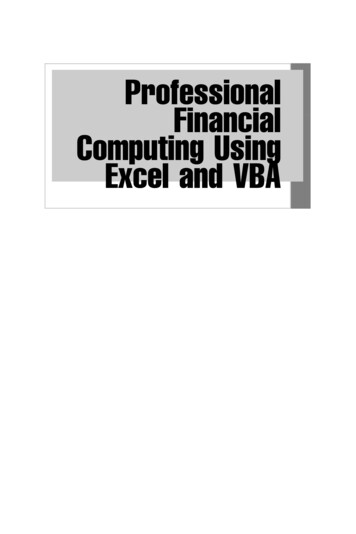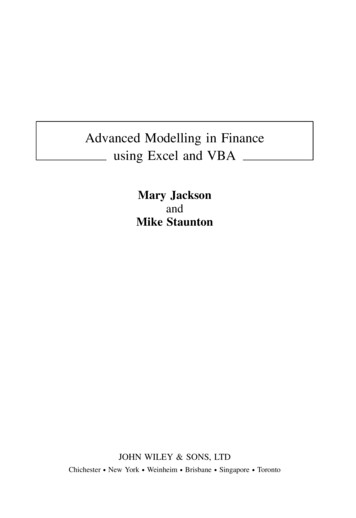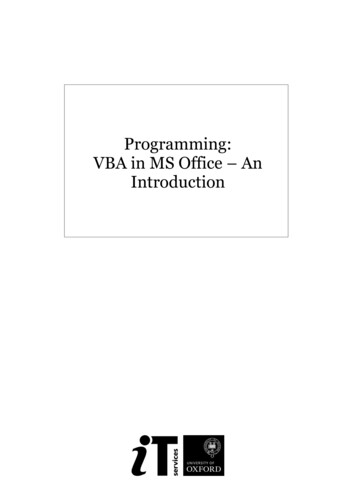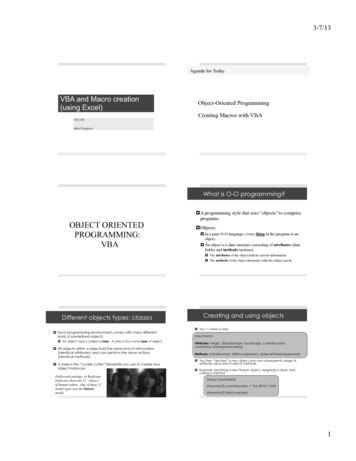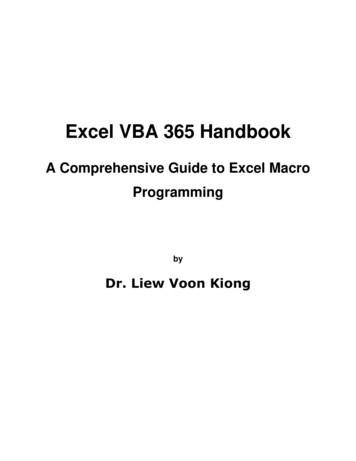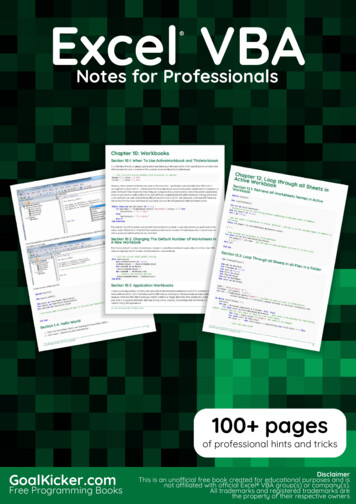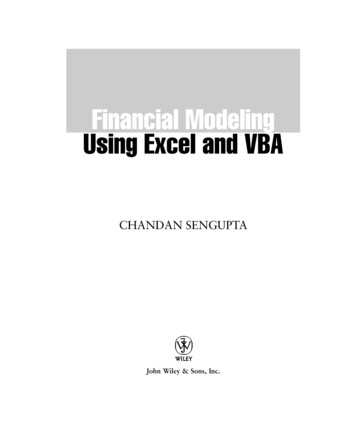
Transcription
3/5/2018Programming Fundamentals In VBA (VisualBasic For Applications)You will learn about basic program writing tools such as inputoutput, variables, branching and looping mechanisms.Online support: A.S.I.C. Beginner’s All-Purpose Symbolic Instruction Code (BASIC)– From: www.acm.org (original full article: http://time.com/69316/basic/) A widely used programming language It was relatively simple to learn (statements were “English-like”e.g., “if-then”) Widely popular and it was commonly packaged with newcomputers in the 1970’s and 1980’s (A then relatively unknown company: Microsoft got it’s initialcash inflows and reputation producing several versions of thelanguage)Administrative and course introduction1
3/5/2018Visual Basic A newer programming language developed by Microsoft It was designed to make it easy to add practical and usefulfeatures to computer programs e.g., programmers could add agraphic user interface, database storage of information etc. Also it can take advantage of the built in capabilities of thevarious versions of the Windows operating system– Why write a feature of a program yourself when it already “comes withthe computer” For more information:– spxVisual Basic For Applications (VBA) Shares a common core with Visual Basic.– Statements ‘look’ similar Unlike Visual Basic, VBA programs aren’t written in isolation(creating a program just for it’s own sake).– Most programs are written to be standalone: a computer game can berun without (say) running a web browser or MS-Office. VB Visual Basic, VBA Visual Basic for Applications Each VBA program must be associated with a ‘host’ application(usually it’s Microsoft office document such as MS-Word butother applications can also be augmented by VBA programs).– The host application is enhanced or supplemented by the VBA program– “Why doesn’t this stupid word processor have this feature?!!”- Now you can add that feature yourself using VBAAdministrative and course introduction2
3/5/2018Visual Basic For Applications (VBA): 2 Important! Because every VBA program must be run withinthe context of host application when you are learning to writeyour programs do not open up an important MS-Worddocument and run your programs.– The host program often needs an Word document in order to run certaincapabilities.– VBA programs often change documents (formatting, style, text).– Therefore use only small ‘test’ MS-Word documents when running yourVBA programs otherwise your information may be lost or corrupted.Macros Macro: a sequence of keystrokes or mouse selections(instructions to the computer) that can be repeated over andover– MS-Office can be augmented by writing Macros (essentially computerprograms) that will run either for multiple documents or only for aparticular document.– In this class we will focus solely on MS-Word macro programming VBA (as guessed) is an example of a macro programminglanguage e.g., you can write a program that includes a series offormatting and other commands that you frequently carry outin Word documents Write the commands once in the form of a program and justre-run this program instead of re-entering each commandAdministrative and course introduction3
3/5/2018Macros And The Web-Based Office According to Microsoft macros are not accessible via theironline Office b6?CorrelationId 917b1609-97e9-4cc7-9eeb-d188939ad740&ui enUS&rs en-US&ad US Result: use a computer with the desktop version of Officeinstalled.– 203 lab– Other campus computers Some ‘labs’ may have open access hours– It is CRUICIAL that you test your program on the computers in the 203 labbecause your assignment must work on the lab machines in order toreceive credit.Writing Macros It is not assumed that you have any prior experience writingcomputer programs (macro language or something else). Consequently early examples and concepts will be quiterudimentary i.e., “we will go slow”– The effect is that you may find that the capabilities of the early exampleswill duplicate familiar capabilities already built into MS-Word Why are we writing a macro program for this feature? Makes it easier to understand (you know the expected result). Keeps the example simpler. Later examples will eventually demonstrate the ‘power’ ofmacros– You can do things that would be impossible (or at least difficult) with thedefault capabilities built into MS-WordAdministrative and course introduction4
3/5/2018Assignments: 203 vs. 217 Program size (CPSC 217 non-majors programming class):– A text-based computer game “The hobbit”: 677 line program Program size (this class):– VBA (changing the capabilities of MS-Word): 60 line program– JavaScript (running a program through a web page): 70 line programFinal Exam: Programming Questions Average grades (programming questions, final exam):– The values indicate that the typical student shows a reasonable grasp ofthe material (i.e., they did “get through it”)– In order to do well you need to be coming to class and doing extra work: The absolute minimum workload is to complete the assignment Write and trace as many programs as you have time for The more practice you get, the more skilled and knowledgeable you will becomeAdministrative and course introduction5
3/5/2018Can You Complete The Following Tasks? Open a MS-Word document and replace every instance of onephrase e.g., tamj@ucalgary.ca with anothertamj@cpsc.ucalgary.ca Open every document in a folder and perform the same searchand replace operation:–––––2 documents?10 documents?100 documents?All the documents in a particular folder?What if you just wanted to open the word documents with a particularword or phrase in the name e.g., “assignments 2014”? This is an example where writing a macro once is a moreefficient approach– One answer to the question: “Why are we learning this?”Advanced Use Of Macros Although it’s beyond the scope of this class the followingexample is introduced now to make you aware of the power ofVBA and macro languages.– It can actually be used to perform real tasks. You can use a macro to take advantage of the capabilities ofeach MS-Office application:– Establishing references to applications to ‘link’ them– Take the output from one application and making it the input of another.Administrative and course introduction6
3/5/2018Advanced Use Of Macros (2) Example: macros can automate the following task––––Store data in MS-AccessStore the query results in MS-Excel and perform calculations on the dataUse the formatting capabilities of MS-Word to produce reportsMS-Outlook can email the final documentsViewing The ‘Developer’ Ribbon (MS-Word) The macro programming capability comes built-in to the MSOffice suite.– You simply have to enable that functionality Steps1. Select the ‘File’ ribbonAdministrative and course introduction2. Select ‘options’7
3/5/2018Viewing The ‘Developer’ Ribbon (MS-Word): 23A) Select “customize the ribbon”3B) Check the ‘Developers’ boxViewing The ‘Developer’ Ribbon (MS-Word): 3 This should add a new ribbon “Developer”Administrative and course introduction8
3/5/2018Alternate: View And Run Macros You may or may not be able to edit the MS-Word ribbon withsome computer labs.– Or the changes you make to Word only last until you logout. You can see view macros via the ‘view’ tab on the ribbon(albeit with fewer options)Macros And Computer Security Computer viruses are simply malicious computer programs. Macros can be a useful mechanism for reducing repetition oradding new capabilities to MS-Office. But as is the case when writing a computer program maliciouscode can also be written with a macro and the virus can beactivated by just opening the MS-office document thatcontains the macro. Just because you are writing macro programs does not meanthat you shouldn’t take macro security seriously!Administrative and course introduction9
3/5/2018Examples Macros Viruses “Melissa”: Information about an old but ‘successful’ MacroVirus– 02.idg/index.html? s PM:TECH– http://www.symantec.com/press/1999/n990329.html– http://support.microsoft.com/kb/224567 Macro viruses aren’t just “ancient history”, take the potentialthreat seriously!– http://www.symantec.com/avcenter/macro.html– cyclopedia/search.aspx?query Virus– http://ca.norton.com/search?site nrtn en CA&client norton&q macro virusWhich Document Contains A Macro?Administrative and course introduction10
3/5/2018Question: What Is The Security Difference? Opening the following documents:– Document.docm– Document.docx– Document.docTypes Of Documents That Can Contain Macros(Type ‘M’) You can store the macros that you write for this class this way– In a single document ‘doc-m’ document You can also store macros in these documents (not for thisclass but important to be aware in terms of computersecurity).– Normal ‘dot-m’ template i.e. “Normal.dotm” Default template used to produce all Word documents (formatting, layout etc.)– Custom ‘dot-m’ template e.g. “histPaper.dotm”, “psychPaper.dotm” You can override the default by creating your own template documentsAdministrative and course introduction11
3/5/2018Viewing File Information: Learning What Type Of FileIs That Word Document View details: select ‘view’ in a folderViewing File Suffixes In a folder select: Tools- Folder options Under the ‘view’ tab uncheck ‘Hide extensions for known filetypes’Administrative and course introduction12
3/5/2018.DOCX (And .XLSX, .PPTX) These types of files cannot have macros attached to them.– Reduced capabilities (no macros) but increased security (no macros) Question: Are these files with these extensions 100% safe?File nameextensions hiddenEnabling the display offile name extensionsMacros And Security Cannot contain macros– MS-Office files that really end in ‘x’ e.g. “docx”, “xlsx”, “pptx” etc.– When you save a document in Office 2007 (or newer) it will in one ofthese file types. May contain macros– Template documents, end in dot-m e.g. Normal.dotm– Older (Office 97 to 2003) Office documents e.g. “doc”, “xls”, “ppt” etc.– Macro-enabled documents, end in m e.g. “docm”, “xlsm”, “pptm”Administrative and course introduction13
3/5/2018Enabling Macros To Run If you can' t run macros in MS-office (you see odd errormessages) then examine the "Trust Center“ settings in Word1. Select the ‘File’ ribbon2. Select ‘options’Enabling Macros To Run (2)3A) Select “Trust Center”Administrative and course introduction3B) Select “Trust Center Settings”14
3/5/2018Enabling Macros To Run (3)4A) Select “Macro Settings”4B) Select “Disable all macros with notification”MoresecureLesssecure5) Exit MS-Word (close ALL documents)Enabling Macros To Run (4) The default setting for MS-Word should already be set to“disable macros with notification” but these steps will allowyou to use machines that aren’t set to default values.Administrative and course introduction15
3/5/2018Effect: Opening Word Documents Using the default setting will disable all macros by default(safer approach) but you can still enable the macros as thedocument is opened.JT’s caution You should NOT casuallyselect this option for all MSWord documents It’s recommended that youONLY enable macros youhave created (or the lectureexamples)Macro Security DO NOT take the ‘easy’ way outMoresecureNO!LesssecureFor more HA010031071.aspxAdministrative and course introduction16
3/5/2018Creating Macros1. Record the macro automatically: keystrokes and mouseselections will be stored as part of the macro (you will bebriefly shown how to do this in tutorial)2. Manually enter the Macro (type it in yourself into the VBAeditor) This is how you are to complete your assignment and is how many VBAprograms are created.The Visual Basic Editor You don’t need to familiarize yourself with every detail of theeditor in order to create VBA programs. Just a few key features should be sufficient Starting the editor:– Because VBA programs are associated with an office application open theeditor from MS-Word– Click the “Visual Basic” icon under “Developer”Administrative and course introduction17
3/5/2018Overview Of The Important Parts Of The VBAEditorSaveCut, copy,pasteFind,replaceHelp lookupProgrameditorUndo,redoExport:Useful fortransferring orbacking upyour workRun, pause,stop (VBAsubroutineprogram)CurrentlocationVBA Editor: Don’t Mix It Up With The Word EditorAdministrative and course introduction18
3/5/2018Viewing Macros All macros that you have created can be viewed in the VBAmacro editor:– Macros manually entered in the editor (Message Box example)– Macros automatically recorded (not covered in lecture but in tutorial)Writing A Program In The VBA Editor Format:' Program documentation goes here (more on this later)sub sub-program name ()Instructions in the body of program (indent 4 spaces)End Sub Example:' Author, version, features etc.Sub first example macro info()MsgBox ("Congratulations! This your first computerprogram")End Sub Note: large VBA programs have multiple (sub) parts but for thisclass you only need to define a single ‘sub’.Administrative and course introduction19
3/5/2018Program Structure And The ‘Sub’ Keyword Sub stands for ‘subroutine’ or a portion of a VBA programHeader, start of subroutine:Format:1. Has word ‘Sub’Sub subroutine name ()2. Name of subroutine Instructions in the subroutine 3. Set of bracketsEnd SubNote: all lines in between areindented (4 spaces) Example:Sub First Example Macro Info()End of subroutine: Has ‘End Sub’End Sub Unless otherwise told all VBA program statements must beinside the subroutineThe ‘Sub’ Keyword: 2 Real world VBA programs will be broken down into multiple‘subs’ (subroutines or program parts) Again: Because this is only brief introduction into writing VBAprograms you will only have to define one subroutine for yourassignment.Administrative and course introduction20
3/5/2018Naming The Subroutine This is what follows the ‘sub’ keyword. ExampleSub formattingResumeEnd Sub Naming standards:– The name chosen should summarize what the program is supposed todo.– The choice of the name will play a role in determining your assignmentgrade.Choosing A Name: VBA Technical Requirements Must start with an alphabetic letter, after than anycombination of letters and numbers may be used– OK: “assigment1”, “a2939”“*assignment”Not OK: “1assignment”, Maximum length of 80 characters It cannot contain spaces, punctuation or special characterssuch as # or !– ‘resume headings’ (Not Allowed: space character)– ‘macros!’ (Not Allowed: special character) Can contain underscores (separate long names)Administrative and course introduction21
3/5/2018VBA Programming: How To Study At the very least: try typing the programs into the VBA editoror cutting and pasting them yourself (watch for alteredcharacters such as quotes)Sub first exampleMsgBox(“This For the more complex programs (end of this section as well asthe next section) try re-creating the programs on your own:– Think about what tasks are accomplished by my solution program– Without looking at my solution try entering into the program into theVBA editor to accomplish these same tasks With programming you learn by “doing yourself” rather thanby watching someone else ‘do’First VBA Example Learning Objectives:– Creating/running a VBA program– Creating a Message Box “MsgBox” Reminder steps (since this is your first example)– Start up the application (MS-Word)– Invoke the VBA editor: Developer- Visual Basic– If successful you should see something similar to the imageEnter your programinstructions here(program editor)Administrative and course introduction22
3/5/2018First VBA Example (2) Type in or cut-and-paste the following example into the VBAeditor (see last image for location of the editor, previous slide)– This is NOT the same as pasting it directly into MS-Word.– Word document containing the macro (empty document see the macroeditor for the important details): 1firstExampleMacro.docmSub first example macro info()MsgBox ("This is your first computer program")End SubReminder: Running Macros (You must first have the ‘developer’ tab visible). Developer- Macros The single macro should be highlighted, then click ‘run’Administrative and course introduction23
3/5/2018Running VBA Programs You Have Entered (2) Or you can run the program right after you have entered it (inthe editor).1. Ensure correctprogram “sub” isto be executed(click there)2. Press the‘play/run’ buttonor “F5”Structure Of VBA Programs: Reminder Of ImportantPoints As you just saw a program must beginwith the “sub” keyword followed bythe name of the “subroutine” (subpart of the program). It also ends with end “end sub” Important style requirement: Thepart between the ‘sub’ and ‘end sub’must be indented by 4 spaces (8spaces if sub-indenting is used – nextset of notes).Administrative and course introductionsub first example macro()MsgBox("Congrats!")end Sub24
3/5/2018Saving Your MacroYou can save your macro into a Word document:1. Create a new Word document2. Save the document as a macro-enable document (Worddocument that has a macro computer program embeddedwithin it).Saving Your Macro (2)3. Next you have tell Word that you want to save your macroprogram inside this macro-enabled document.– By default when you save your macros Word will select “Normal.dotm”(All documents) as the location. DO NOT save your macro in this document:–You will have trouble transferring your macro to other computers–Because “Normal.dotm” is the default template used to create some Word documentsit may result in security warnings (all Word documents will have macros included)Administrative and course introduction25
3/5/2018Saving Your Macro (3)– Instead: Save your macro in your current document (in the examplebelow it’s “Assignment4.docm”. Transferring this document will allow the macros to be transferred as well.Transferring Your Macros (This Class) If you create a macro-enabled MS-Word document (file namesuffix “.docm”) then transfer the Word document itself. Save the macro enabled word document to your portable USBflash drive OR Save the template document on your web disk drive (or anyother ‘cloud’ storage system such as Dropbox.com)– To download files stored on web disk onto another e and course introduction26
3/5/2018Message Box (Details of the previous example) Creates a popup window to output information from yourprogram Useful for testing– Is my program working?– Which part is running? Also useful for displaying status messages about the currentstate of the programCreating A Message Box Format:MsgBox (" Message to appear ") Example:MsgBox ("This your first computer program")Notes on ‘Format’: Italicized: you have a choice for this part Non-italicized: mandatory (enter it as-is) Don’t type in the angled brackets (used to help you visually group)Administrative and course introduction27
3/5/2018VBA Visual Aids: Function Arguments As you type in the name of VB functions you will see visualhints about the arguments/inputs for the function.Function arguments(Bold): mandatoryarguments– JT: You won’t need to worry about all functional arguments for this class.– Enter the function name and then a spaceVBA Visual Aids: Error Information The requirements for forming VBA programming instructionsare referred to as the ‘syntax’ (grammar/rules) of the language. Syntax violations are visually highlighted in VBA:Required argument missingPart of program that containserrors (yellow highlight)Specificstatement/instructioncausing the error (red font)Administrative and course introduction28
3/5/2018Basic Mathematical OperatorsOperationSymbol used in VBAExampleAddition 2 2Subtraction-3–2Multiplication*10 * 10Division/81 / 9Exponent 2 3Variables Used to temporarily store information atlocation in memory Variables must be declared (created) beforethey can be used. Format for declaration:CPSC mailTAMDim Variable name as Type of variable Example declaration:Dim BirthYear as LongAdministrative and course introduction29
3/5/2018Common Types Of VariablesType of informationstoredVBA NameExample variabledeclarationDefault ValueWhole numbersLongDim LuckyNumberas Long0Real numbersDoubleDim MyWeight AsDouble0Chararacters1String2Dim Name AsStringEmpty stringDate3DateDim BirthDate AsDate00:00:001) Any visible character you can type and more e.g., ‘Enter’ key2) Each string can contain up to a maximum of 2 billion characters3) Format: Day/month/yearCPSC mailExamples Of Assigning Values ToVariablesTAMmailNote: some types of variables requires somemechanism to specify the type of information to bestored: Strings: the start and end of the string must be marked with doublequotes " Date: the start and end of the string must be marked with the numbersign #Dim LuckyNumber As LongLuckyNumber 888Dim BirthDay As DateBirthDay #11/01/1977#Dim MyName As StringMyName "James"Administrative and course introduction30
3/5/2018Common Mistake #1 A variable is just that – it can change as a program runs. Approach #1: variable not used (lacks flexibility)MsgBox ("My age is.")MsgBox (".37") Approach #2: variable employed (age can be changed with anymathematical expression)Dim age As Longage 37MsgBox ("My age is.")MsgBox (age)age 38MsgBox ("My age is.")MsgBox (age)Variables: Metaphor To Usewww.colourbox.com Think of VBA variables like a “mail slot in memory” Unlike an actual mail slot computer variables can only holdone piece of information– Adding new information results in the old information being replaced bythe new informationDim num as Longnum 1num 17Administrative and course introductionnumnum11731
3/5/2018Common Mistake #2 Assigning values from one variable does not ‘link’ themnum1 1num2 num1num1 2Variables: Metaphor To Use (2) Also each computer variable is separate location in memory. Each location can hold information independently of otherlocations. Note: This works differently than mathematical variables!Dim num1 as LongDim num2 as Longnum1 1num2 num1num1 2 What is the result?Administrative and course introduction32
3/5/2018MsgBox: Dislaying Mixes Of Strings And Variables Format:MsgBox (" Message1 " & variable name ) Name of the online example: 2variablesMixedOutput.docmDim num as Longnum 7MsgBox ("num " & num)"num "num:: A literal string: contents of a variable (slot in memory)Why Mix The Display Of Strings & Variables Labeling variables as they appear makes your program easierto understand4.33.33.72.04.04.03.91.0Administrative and course introductionVs.Student 1:Student 2:Student 3:Student 4:Student 5:Student 6:Student 7:Student 8:4.33.33.72.04.04.03.91.033
3/5/2018Student Exercise: Mixed Output What is the output of the following MsgBox:Sub exercise1()Dim num As Longnum 12MsgBox ("num " & num)End SubOption Explicit It’s not mandatory to include for your program “to work”. But including it at the very start of your program before the‘sub’ and subroutine name will save you many headaches! More details will be provided in tutorial.Administrative and course introduction34
3/5/2018Third VBA Example Learning Objectives:– Using variables– Using mathematical operatorsThird VBA Example (2)Word document containing the macro: 3types.docmSub thirdExample()Dim RealNumber As DoubleDim WholeNumber As LongRealNumber 1 / 3MsgBox (RealNumber)WholeNumber 5 / 10MsgBox (WholeNumber)WholeNumber 6 / 10MsgBox (WholeNumber)End SubJT’s note: Anything over 0.5 is rounded upAdministrative and course introduction35
3/5/2018Variable Naming Conventions Language requirements:– Rules built into the Visual Basic (recall VBA is essentially Visual Basictied to an MS-Office Application) language.– Somewhat analogous to the grammar of a ‘human’ language.– If the rules are violated then the typical outcome is the programcannot execute. Style requirements:– Approaches for producing a well written program.– (The real life analogy is that something written in a human languagemay follow the grammar but still be poorly written).– If style requirements are not followed then the program can executebut there may be other problems (e.g., it is difficult to understandbecause it’s overly long and complex - more on this during the term).Naming Variables: VBA Language Requirements Names must begin with an alphabetic character– OK: name1Not OK: 1name Names cannot contain a space– OK: firstName Not OK: first name Names cannot use special characters anywhere in the name– Punctuation: ! ? .– Mathematical operators: - * / – Comparison operators: Administrative and course introduction 36
3/5/2018Naming Variables: Style Conventions1. Style requirement (alllanguages): The name should bemeaningful.Examples#1:age (yes)x, y (no)2. Style requirement (from theMicrosoft Developer Network1):a) Choose easily readableidentifier namesHorizontalAlignment (yes)AlignmentHorizontal (no)b) Favor readability overbrevity.CanScrollHorizontally (yes)ScrollableX (no)1 spxNaming Variables: Style Conventions (2)3. Style requirement: Variablenames should generally be alllower case except perhaps forthe first letter (see next point forthe exception).4. Style requirement: For namescomposed of multiple wordsseparate each word bycapitalizing the first letter ofeach word (save for the firstword) or by using an underscore.(Either approach is acceptablebut don’t mix and match.)Examples#3:age, height, weight (yes)HEIGHT(no)#4firstName, last name(yes to either approach)5. Avoid using keywords as names(next slide)Administrative and course introduction37
3/5/2018Some Common Visual Basic etLibModModuleOnOperatorOverrides PartialResumeReturnSingleStaticThenThrowVariant ionPrivateSelectStepToWhile1 The full list can be found on the MSDN spxVariable Naming Conventions: Bottom Line Both the language and style requirements should be followedwhen declaring your variables.Administrative and course introduction38
3/5/2018Getting User Input A simple approach is to use an Input Box Format: Variable name InputBox( "Prompt" , "Titlebar" ) Example:Name InputBox("What is your name", "Getting Personal") Note: only the string for the prompt (first) is mandatory. If the title bar information is omitted then the default is theapplication name (“Microsoft Word”)Example: InputBox Learning: getting user input with an InputBox Word document containing the macro:4inputBox.docmSub InputExample()Dim age As LongDim name As StringDim dogAge As Longname InputBox("What is your name", "Getting personal: name")age InputBox("What is your age", "Getting even more personal: age")dogAge age * 7MsgBox (Name & " your age in dog years is " & dogAge)End SubNote: there are two input boxes, one that prompts for the name and the otherfor the age. Each is given a self-descriptive name to distinguish them (anexample of good programming style – more on this shortly)Administrative and course introduction39
3/5/2018The VBA Debugger ‘Bug’:– An error in the logic of your program.– The program “doesn’t do what it is supposed to do”– Example: an erroneous formula for calculating an area of a rectanglearea length width– Bugs will seldom be this obvious Debuggers can be used to help find errors in your program More information on using the VBA debugger will be providedin tutorialScreenshot: www.computerhistory.orgProgram Documentation Your VBA assignment submission must include identificationabout you and information the features of your program– Full name– Student identification number– Tutorial number– List the program features (from the assignment description) and clearlyindicate if the feature was completed or not completed.– Program version DON’T just enter this information into your programinstructionsInstructions for thecomputer(Computer): problem, I don’t know howto run the “James Tam” instructionAdministrative and course introduction40
3/5/2018Program Documentation (2) You must ‘mark’ this information so it doesn’t cause an error– The marking will indicate to the VBA translation mechanism that the lineis for the reader of the program and not to be translated and executed– The marking is done with the single quote ' Format:' Documentation Example:' Author: James Tam No error: Everything after the quote until the end of the linewill not be translated into machine language/binary That means documentation doesn’t have to be a valid andexecutable instructionProgram Documentation (3) Contact information should be located before your program Before the ‘sub’ keyword– Before ‘Option explicit’ if includedDocumentation:marked in redAdministrative and course introduction41
3/5/2018Program Documentation (4) Program features (this will be worth many marks) Example assignment description Program documentation–––––––' Author: James Tam ID: 123456' Version: Nov 2, 2015' Tutorial: 99' PROGRAM FEATURES' #5: Printing: completed' #6: Close and save: not completedetcProgram Documentati
Programming Fundamentals In VBA (Visual Basic For Applications) You will learn about basic program writing tools such as input-output, variables, branching and looping mechanisms. . A newer programming language developed by Microsoft It was designed to make it easy to add practical and useful features to computer programs e.g .
![[MS-VBAL]: VBA Language Specification - Framework](/img/22/ms-vbal.jpg)
